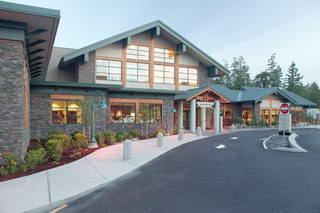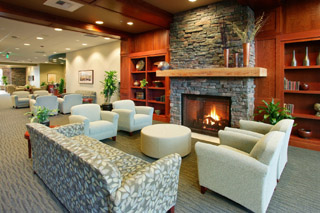
DJC.COM
April 24, 2008
Boomers lifting standards for patient care
BCRA

Anderson
|
When’s the last time you visited your physician’s office and actually enjoyed the experience?
Did you get an impersonal response from the receptionist who only wanted the facts and figures of your problem, or were you offered a warm cup of tea and the opportunity to schedule a relaxing massage? Were you prescribed exercise to improve your quality of life, or were you invited to join a health program and partner with others in a stimulating physical routine?
These concepts sound extreme, but they are truly starting to become the standard of practice for many health care delivery systems.
As our population is continuing to age it’s interesting to note a shift in the delivery system, primarily as a result of patient expectations, and perhaps, demands. The largest population sector that has now reached the critical stage of health care needs is the most affluent in American history — the baby boomer generation.
This is the group of people who were born during the post-World War II and Korean War years and are just now reaching retirement age. With them they are bringing more personal wealth than the previous adult populations. Along with their money, and in keeping with their spoiled nature (yes — includes myself), they want a higher quality of service for their health care experience.
A relaxed experience

Photos by Dane Gregory Meyer, courtesy of BCRA The MultiCare Gig Harbor Medical Park outpatient building was designed with heavy timber and stone in the style of a Northwest lodge. Valets park cars for free. |
In response to this challenge, health care providers are beginning to move to a new style of delivery intended to make patients and family members have a more comforting, relaxed experience as part of their visit.
It starts with entering into a hotel-style lobby with a concierge-type receptionist that serves only to greet people and direct patient traffic. The lobby atmosphere typically features the warmth of a fireplace, the tranquility of a fountain and the luxury of a latte and a scone with overstuffed, yet patient-friendly seating.
Patients can enjoy these amenities in a lounge-style waiting room or proceed to individual patient-care zones where they are again greeted — this time by name (already sent electronically to the destination zone by the concierge). Patient care needs can now be addressed in a smaller, more private environment without the entire waiting room overhearing the conversation.
Along with this change of environment at the front end of the patient experience, the types of care that are being offered are also changing.
Most health care facilities recognize that the time a patient has to commit to their health care needs is very valuable and not to be wasted by simply sitting in waiting rooms followed by more sitting in the treatment care areas. Patients can now have the opportunity to schedule other activities such as massages, physical exercise routines, low-impact aerobics, facials or other services on either side of their health appointments.
Let’s look at a recently completed facility as an example of this new model of patient delivery.
New model in action

MultiCare’s hotel-style lobby is furnished with overstuffed chairs and a fireplace. A concierge greets patients and directs traffic. |
In June 2007 the MultiCare Gig Harbor Medical Park opened as a new full-service outpatient care center to serve the community on the west side of the Tacoma Narrows.
Before, the community either had to settle for smaller local health care providers or travel across the water towards downtown Tacoma. This new facility is the first of several providers that have recognized a growing market demand in the Gig Harbor and Kitsap County region for locally provided health care.
In 2004 MultiCare Health Systems chose to move forward with their new center, and the architects were charged with providing a design unlike anything that existed within the MultiCare system.
Initially conceived as a women’s center, the facility expanded to become a full-service center to serve patient needs of various types.
The design of the facility had to conform to two very specific requirements: First, the building had to reflect the historic heritage of “the harbor” yet be a state-of-the-art health care facility; and second, the building would use a new model of health care delivery — that of concierge-style patient care.
BCRA, the architectural firm selected to design the facility, responded to the challenge by creating a building that provides a low-key image of heavy timber and stone, similar to a Pacific Northwest lodge. While the building has only two stories, it actually includes nearly 100,000 square feet of patient care services. Encompassing a wide range of services such as 24/7 urgent care, imaging (with a wide variety of modalities), primary care, women’s care and a full-scale ambulatory surgical center, the facility has gone beyond the traditional outpatient center. Additional services include a sleep center, women’s exercise facility and retail outlet for women and young mothers.
Growing acceptance
One of the most interesting developments as part of this entire process was the paradigm shift made by MultiCare.
As the project planning unfolded, staff from MultiCare voiced uncertainty about how to deliver health care in the concierge style. They wondered who would really want to work in such an unorthodox operation, and whether MultiCare would be able to attract physicians and other new staff members to work there.
Surprisingly, as the project moved forward through design, MultiCare soon found their new facility couldn’t be built large enough to accommodate all the staff and care services that wanted to locate there.
Sure, there have been transitional challenges to training the staff, and there have been minor difficulties with getting a large building up and running. Still, the feedback from the Gig Harbor staff, as well as from patients and the public, has been resoundingly positive.
Sounds like a formula for success.
Dale Anderson, AIA, NCARB, LEED AP, CSBA, is a BCRA principal and sustainable design specialist who has been practicing architecture since 1973. He is currently the chair of the U.S. Green Building Council’s Cascadia Tacoma/Olympia Branch.
Other Stories:
- Architects play key role on health care team
- How BIM helped a hospital go green
- Time to improve hospital energy standards
- Boomers influence next generation of senior housing
- Innovative structures help hospitals cut costs
- For patients, silence is golden
Copyright ©2009 Seattle Daily Journal and DJC.COM.
Comments? Questions? Contact us.